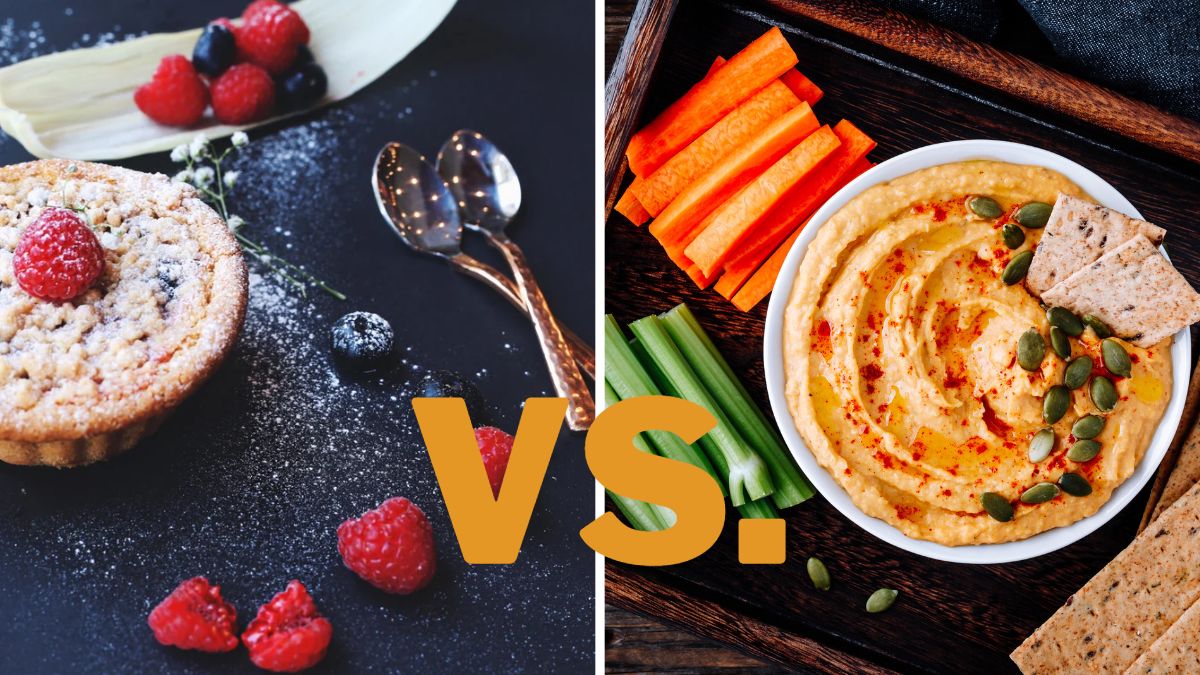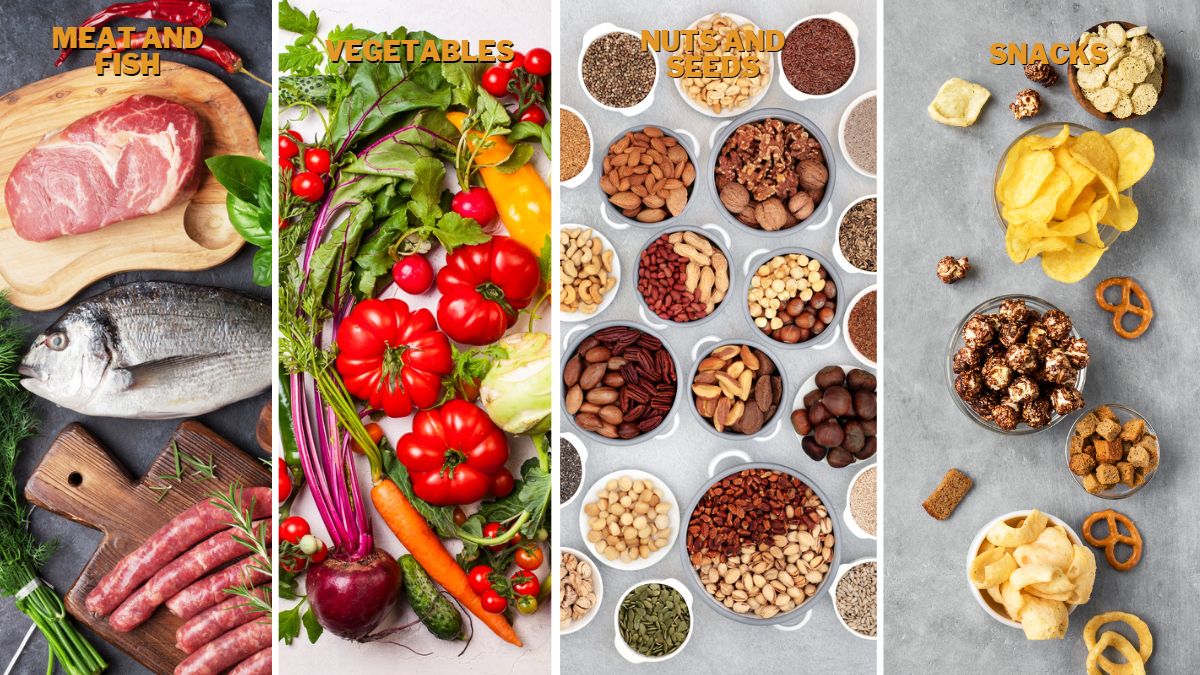Sweet or Savory: Differences & Examples

Normally described as contrasts, sweet and savory are opposite tastes food can have. Sure, food can be at the same time sweet and savory. Sugar-coated peanuts are an example of that. But normally, food is either sweet or savory. What is, then, the difference between sweet and savory?
Sweet food has the taste of sugar and honey. Fruits, chocolates, cakes, and candies are just a few examples of sweet foods. Savory food, on the other hand, is a non-sweet full-flavored food, like meat or fish, vegetables, and snacks.
There are five different flavors on the flavor spectrum: sweet, salty, bitter, sour, and umami (also known as savory). In this article, I’ll focus on the two flavors that are said to be on opposite sides of this spectrum: sweet and savory. I’ll explain their differences, give examples of food in each category, and even show you why savory food can be considered better than sweet food.
What Are the Differences Between Sweet and Savory?
The main differences between sweet and savory food are their taste and how their consumption can impact our bodies and health. If you consume sweet foods to indulge your sugar cravings and feel good, then the reason behind eating savory foods is to stop feeling hungry, thus answering a basic need from your body.

Sweet and Savory Flavor Differences
If you eat something sweet, you’ll get a sugary, honey flavor in your mouth. The sugar present in sweet foods can be either natural (like fruit) or “created” (which happens when you add processed sugars to other ingredients, like when you use sugar as one of the ingredients to bake a cake).
On the other hand, if you choose to eat something savory, you will get a saltier and richer flavor. Sometimes spicy, savory food can be perceived as all food that is not sweet.
How Different Food Impacts Your Body and Health
Savory foods provide protein, nutrients, and essential fats. By consuming savory food, you will feel full and satisfied. You will be answering a fundamental need: hunger. One ingredient that is present in most savory foods, however, can harm your body and health. That is salt. When consumed excessively, salt can affect your blood pressure and increase the risk of heart disease or stroke. [1]
On the other hand, sweet foods provide quick sources of energy and are perceived, by your body, as a positive reward. When you eat something sweet, you’ll feel a sugar rush in your veins and feel good and energized. That is because sugar, the ingredient that makes food sweet, will produce high levels of dopamine when consumed. [2]
Ever wondered why, from time to time, you’ll find yourself craving something sweet? That is because, in reality, your body is most likely, addicted to sugar. How can that be? It is easy. The last time you ate sugar, you were rewarded with a “feel good” sensation, so your brain wants to do it repeatedly.
Also known as the pleasure hormone, dopamine signals the brain to identify a specific activity as positive. In short, your brain is telling you that eating sweet food is good and that you can do that again. You are led to find more sweet foods to get more rewards. A vicious cycle starts. Sugar, like drugs, is addictive. And, like drugs, sugar will have several effects on your brain that are similar to the ones an addict has when they are either high or withdrawing drugs. [3] Here are a few examples:
Bingeing – the more you eat, the more you crave. You can never have too much sugar.
Cravings – suddenly, your body is telling you that you “need” to eat something sweet. This can happen if you aren’t giving your body the usual amount of sugar.
Withdrawal – anxiety, changes in sleep, and even depressing feelings are only a few of the symptoms your body goes through when it is missing sugar.
Examples of Sweet Food
It is easy to identify when a specific food is sweet: it has sugar. Added or naturally created, these foods will all have a delicious taste of sugar.
Cakes and cookies – normally baked using processed sugars, cakes and cookies are seen as sweet foods that we can have for dessert or as a snack. Many times, used for a celebration, cakes, and cookies, are the perfect personification of sweet food: something you eat as a reward and to feel good.
Fruit – unlike cakes and cookies, fruit is naturally sweetened and has no addition of refined sugars that are bad for your health. Fruit contains a lot of vitamins that our bodies need. Next time you need something sweet, grab an apple or a kiwi. This way, you’ll be satisfying your sugar cravings more healthily.
It is a fact that sweet things taste delicious and leave you with a “good” feeling. It is also a fact that sugar, the ingredient that gives food its sweet taste, can be addictive and unhealthy. This is the reason why we should always consume sweet foods in moderation.

Examples of Savory Food
In the savory category, you’ll find all the food prepared with the minimum amount of sugar and no pretense of being sweet.
Meat and Fish – both high in protein, meat and fish will help you feel full and satisfy a basic need.
Vegetables – packed with nutrients, vegetables are some of the healthiest savory foods you can eat.
Nuts and Seeds – nuts and seeds can be very healthy when eaten in small quantities. When unsweetened, they make the perfect snack that will keep you satisfied between meals.
Snacks – chips, unsweetened popcorn, and pretzels, among others, are easy snacks you can also have between meals. Sometimes packed with salt and chemicals, it should be consumed in moderation.
As in sweet foods, savory ones can also be unhealthy. When consumed in excess, salt can affect the well-functioning of your heart, kidneys, or liver.

Is Savory the Opposite of Sweet?
It is said that in the flavor spectrum, savory and sweet foods are on opposite sides. Let’s pick an example to better understand how this can be true. For example, if you go to the supermarket, you will find chocolate and cheese crepes. The first is sweet, and they will work better as a dessert. The cheese ones are savory; you can have them as a starter or a main dish.
It is also said that opposites attract each other. Combining the two can create a unique experience for your tastebuds. Combining sweet and savory foods is used by cultures and chefs worldwide. Called flavor layering, this combination will have impacts not only on our tastebuds but also on our brains.
You don’t need to be a world-renowned chef to achieve this level of greatness. You and I create flavor layering dishes every day, in our homes, even without thinking about it. Do you want examples? We combine two opposite flavors when we add sugar to our caramel or green apple slices to our salad. We are flavor layering.
What Is a Savory Taste?
Savory is a term used many times when we want to talk about non-sweet foods. Giving you a full-flavored taste that can, sometimes, be spicy and savory is also known as umami.
Umami is a Japanese food that means “essence of deliciousness” and is the flavor found in savory foods. Umami’s number one role is ensuring we eat enough proteins to maintain healthy organs and live healthy lives. Umami can be found in many foods, including meat, fish, vegetables (like mushrooms), cheese, and soy sauce.
Glutamic acid is what gives savory food its taste, and it is present naturally in most of the foods we consider to be savory. Searching for that holy grail, that is umami, there are, however, some industries that add to their food an addictive called monosodium glutamate. This additive is added to deliver tastier food.
Why Is Savory Better Than Sweet?
Most of the time, savory is better than sweet because savory foods do not include refined sugars, as opposed to sweet foods. This simple fact results in much healthier food. Savory foods provide protein, nutrients, and essential fats, satisfying your hunger and allowing you to have a healthier life. While in the opposite extreme, sweet foods will give you short moments of energy and make you feel happy and good about yourself.
Too much sweet food will probably lead to obesity, type 2 diabetes, and dental decay, among other diseases. Still, there are exceptions, as pointed out above. Fruit is good sweet food, although it has received some negative connotations for the past few years. Yes, it is high in sugar, but it also has many essential vitamins that contribute to our well-being. Like any other food, the fruit must be consumed in moderation so it won’t affect our health.
Heavily salted food, which fits into the savory food category, is also not good for your health. The presence of high amounts of salt in your diet will surely affect your cholesterol and your organs, especially your heart, kidneys, and liver.
Then, is savory better than sweet? Yes, because of the sugar and its implications for your health. Still, both types of foods should be consumed in moderation as too much savory (salty) food can also harm your health.
Which One Is Better: Savory or Sweet Breakfast?
Many people defend that you should start the day with a sweet breakfast, as this will give you the energy you need for the day. That is not so straightforward, though. Both sweet and savory foods can give you the energy you need to start the day. The first, in the form of sugar, will work as a quick shot of adrenaline. The second, through protein, will help you maintain high levels of energy throughout the day.
Then which one of the two is better? Sweet or savory?
To quickly start your day in a healthy way, you need to ensure you include one thing in your breakfast: protein. Then it means a savory breakfast is better? No. For the ones who like to start their day with something sweet, the good news is protein can be found in both savory and sweet foods.
You can find protein both in savory (eggs and bacon) or sweet food (add some fruit to your porridge or drizzle your Greek yogurt with honey). In the end, just make sure you are going for healthy fats and sugars instead of refined ones.
